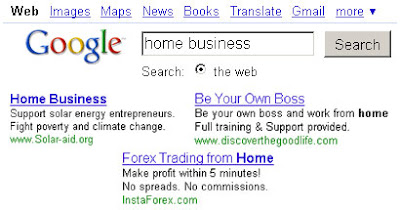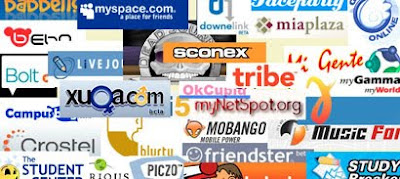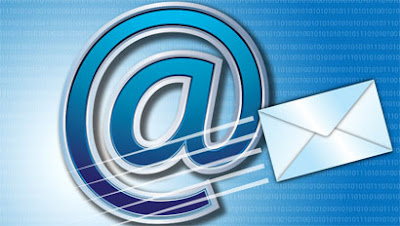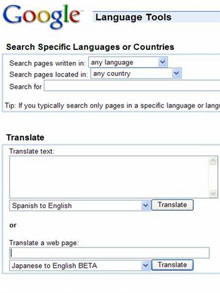Great opportunities for great people!.... Earn more money, without big effort...
Click Here! www.smeglobal.biz/register
Click Here! www.smeglobal.biz/register
HYE EVERYONE...
The Internet has brought media to a global audience. The interactive nature of Internet marketing in terms of providing instant response and eliciting responses, is a unique quality of the medium.
Internet marketing is sometimes considered to have a broader scope because it not only refers to the Internet, e-mail, and wireless media, but it includes management of digital customer data and electronic customer relationship management systems.
Internet marketing ties together creative and technical aspects of the Internet, including:
design, development, advertising, and sales.
The tips below will guide you how to optimizing internet power and grow your business as well. Enjoy it and hope you will make lots of money in your accounts.
Internet marketing is sometimes considered to have a broader scope because it not only refers to the Internet, e-mail, and wireless media, but it includes management of digital customer data and electronic customer relationship management systems.
Internet marketing ties together creative and technical aspects of the Internet, including:
design, development, advertising, and sales.
The tips below will guide you how to optimizing internet power and grow your business as well. Enjoy it and hope you will make lots of money in your accounts.
GOOGLE ADWORDS MARKETING TIPS
 The tips below will guide you in creating AdWords ads that produce higher click throughs while at the same time reduce the price that you are paying for your ad clicks.
The tips below will guide you in creating AdWords ads that produce higher click throughs while at the same time reduce the price that you are paying for your ad clicks.1. Make Sure to Target The Right Audience
Make sure that you target the right audience by choosing the correct language and country/s that you want to appear to.
eg. You may choose to exclude all countries where English is not spoken, written or understood by the majority percentage of the population.
2. Refine Your Keywords Using the Exact Matching Option
The use of square brackets “[...]” around your keyword/s & phrases.
Example:
[google]
[google adwords]
The AdWords ads will then only show up when the search is for the exact same keyword/s or phrase that you have included within the square brackets.
The AdWords ads will not show up for searches that include other searched on keywords. In the example, this would be for searches like “google ads,” or “google mail.”
3. Split Test Multiple Ads At The Same Time
Always, always, always split test 2 or more AdWords ads at the same time, no acceptations!! Commonly known in the printing industry as an A / B split test.
The idea being to find out which one produces the higher click through rate.
You then replace the weakest performing ads with a new ad.
Then continue along with this process in your endless quest to get the highest click through rate as possible. Beat the control.
4. Track The ROI (Return-On-Investment) of Each Ad
Google AdWords track the click through rate on each ad & can also track the ads conversion ratio as well. You can insert the special AdWords tracking link code in each ad to track its conversion rate. An example is, you could setup each AdWords ad with an Google AdWords tracking code link to make insure each of your ads are producing your target return-on-investment.
 5. Include Highly Targeted Keywords In Your Ads
5. Include Highly Targeted Keywords In Your AdsInclude the targeted keywords in the headline and the description of the ad. Google will highlight searched keywords in bold in the ad.
When people scan search results, they look for the keywords they have entered. Searched keywords highlighted in bold certainly help to catch the user’s attention. For this reason, ads with searched keywords usually perform better than ones without.
6. Sell The Benefits before the Features (but still test just in case)
What has worked very well for me over the years is to make sure that you out one or more major benefits in your ad. For example, make more money, stay younger looking, lose weight, get healthier, live happier, etc.
7. Use Attention Getting Words In Your Ads
Start your headline with an attention getting word. For example, “New:, Sale:, Free:, etc.”Make sure your ads stay within the Google AdWords editorial guidelines.
8. Use Words That Create Emotion & Excitement
Use powerful words, call-to-action phrases or emotion provoking phrases and keywords that create enthusiasm and a response
Below are some examples of power words:
learn, free shipping, cheap, at last, tricks, special offer, time limited offer, free, you discover, tips, enhance, fact, sale, etc.
Here are some examples of call-to-action phrases:
* Buy Today – Save 50%
* Download Free Trial Now
* Sale Ends Tomorrow
Make sure the phrase is specific to your business, otherwise Google may reject the phrase.
9. Promote Your Unique Selling Proposition
What makes your product or service better, or different, from the competition? Spell them out in your ad.
For example, one of Amazon.com’s first taglines was “Earth’s Biggest Bookstore.” That’s a powerful USP!
10. Link To Landing Pages that are Relevant to your site
If an ad is for a specific product or service, create a landing page for the ad. Include relevant and useful information to convert the customer. Generally, a well designed landing page will almost always convert more visitors than if you simply sent the visitor to the home page.
11. Remove the Common Words
Remove common words, such as “a, an, in, on, it, of”, etc. Remove every word that does not absolutely need to be in the ad. Make every word count.
12. Eradicate the “FREE” hunters
Deter freebie hunters by including the price of the product or service at the end of the ad. This will improve your overall conversion ratio and lower your average customer acquisition cost.
This may reduce your click through ratio, but that’s OK. After all, you’re not trying to target everybody, only potential customers. In most cases, freebie hunters will never become paying customers.
SOCIAL NETWORK WEBSITE MARKETING TIPS
 Using the very popular social networking platform such as Facebook.com, Friendster.com, Tagged.com, Twitter.com etc. to enhance your business is almost outright necessary. Where most people use the Internet to find information, now there are millions going online to use social networks. It is probably not far-fetched to believe, at some point, most people will be using the Internet to find out information by predominantly using social networks. So how important do you think social networking can be to your Internet marketing?
Using the very popular social networking platform such as Facebook.com, Friendster.com, Tagged.com, Twitter.com etc. to enhance your business is almost outright necessary. Where most people use the Internet to find information, now there are millions going online to use social networks. It is probably not far-fetched to believe, at some point, most people will be using the Internet to find out information by predominantly using social networks. So how important do you think social networking can be to your Internet marketing?Successful marketers know to well the power of socializing online and the old school marketers are now using these networks to grow their business and income as well. It is more important than ever to brand yourself because regardless of what you are promoting and selling people want to know who they are buying from.
Here are 4 simple tips to succeed at Internet marketing through social networking:
1. Begin COMMUNICATING with customers and prospects so they can get to know you. Hiding behind your computer screen will not cut it anymore. Simply join the more popular networks and start making contact with people who can help your business grow and whose businesses you can help grow.
2. Provide QUALITY CONTENT so you can attract more people to your business and with the progression of technology there is very little you CANNOT do to get your content seen by hundreds, thousands if not millions of people.
3. Start HELPING people so you can get more exposure. If you are using the Internet to make money or provide your off line business a shot in the arm it is imperative you do not turn off people by being an overbearing salesperson.
4. SPREAD the right links to everyone. It is a lot easier to provide a link to a social network you belong to. A lot of people are already members and they use these networks consistently to connect with family and friends. Your blog and website links should be on your profile at the networks so it is not necessary to give it to people unless they ask for it.
YOUTUBE MARKETING TIPS
 This is something I believe small businesses can and should be looking to, which come from the experience of several companies who’ve found success on the site:
This is something I believe small businesses can and should be looking to, which come from the experience of several companies who’ve found success on the site:1. Focus on something fun, something that people will want to share with friends.
2. Clearly demonstrate the product you’re marketing.
3. Make sure the video is real; no tricks, no “smoke and mirrors.”
4. Encourage viewer participation and support, i.e. — “make your own video like ours.”
5. Take advantage of YouTube tags; use adjectives to target people searching based on mood; and match your title and description to the tags.
6. Experiment!
TO A PERFECTLY OPTIMIZED WEB PAGE TIPS
 There is so much talk out there about what the ‘perfect’ web page looks like. In this article we give you tips on what we consider perfectly optimized as well as tips on helping turn the page into a great conversion tool.
There is so much talk out there about what the ‘perfect’ web page looks like. In this article we give you tips on what we consider perfectly optimized as well as tips on helping turn the page into a great conversion tool.Step one – Know who you are targeting
As with any marketing campaign the first step in optimizing ANY web page is to know your target audience. Is your site B2B (business to business) or B2C (business to consumer). This is important because this not only affects the tone of your site, but also the keywords you chose.
It is imperative that you nail who your target is before you do anything else because if you don’t it doesn’t matter how big your site is, or how many pages you have. If you don’t write to the right crowd you aren’t going to get too much business.
The best thing is to write down who you think the target is. Be as detailed as possible. For example, your target may be a 30-45 year old female, in middle management, who drives a mini-van and takes her 3 kids to school before she goes to work. She makes $45,000 per year and has a bachelors degree in finance. This is the type of detail you need. You should be able to picture this person in your mind. Not just the abstract idea of her, but a physical look as well. the better you can picture them in your mind the more successful you will be.
Once you know who you target is the next step is choosing keywords.
Step two – Choosing the right keywords
This may be the most difficult part of your journey, especially if you don’t fit the target profile. That is, picking the keywords they will use to find your site.
You can start by using free tools like Yahoo!s keyword suggestion tool. It gives you a good place to start picking keywords.
Start with a phrase you know your site is about (i.e. if you sell widgets, then simply put “widgets” in the search box). The tool will then not only spit out other related words, but also the search volumes associated with each for the previous month.
A word of caution however: Sometimes, depending on when you use the tool, the search volumes are from a couple months ago. So if your product is seasonal based, the numbers may actually be lower or higher than represented.
Don’t be afraid to get a few hundred words to start. Remember, right now you are just gathering ideas – phrases that could drive traffic to your site. They aren’t all necessarily being used by your target customer.
You can also go to Google’s Adwords site and perform the above steps. Start with a phrase or two which describe your site or product and use Google’s suggestion tool to help expand your list.
At this point you want as many phrases on your list as possible. Don’t worry, you will cull the list pretty quickly.
Once you have a huge list of words, the next place to go is a site like Wordtracker, which has a keyword analysis tool. This tool can be used for a one time fee, or if it’s something you might want to return to you can purchase a subscription. It is a fairly simple tool to use and will give you a good idea of just how likely your site will be able to compete for a phrase.
A warning about Wordtracker: The software uses search volumes from some fairly minor sites such as Dogpile, so the estimates could be a little skewed. But again, unless you deal with an SEO firm that has their own proprietary software, this is about your best alternative.
Also remember as you are culling your words, don’t just focus on the competitive factors. These won’t account for your target audience. Therefore you need to have that picture in your mind of the target as you are selecting phrases that they might use. If you are unsure, you could always as for help from friends and family that fit the target profile.
A good rule of thumb would be to chose about one phrase per page. That doesn’t mean that you will only have one page per phrase, but it gives you a good target. So if your site is 300 pages, consider having a list of 300 phrases.
Step 3 – Write your pages
Now that you have your keywords its time to write, or re-write, your content to make them more appealing to the target audience, inserting the key phrases you’ve selected whenever possible.
Keep in mind that you don’t want to over do it. Also now is a good time to ensure you have proper keyword density’s and page length.
I recommend pages that are 400-500 words long. If they are a little longer or shorter that is fine, however if they are approaching 1000 words or more you should split them up, trying to hit that 400-500 word limit.
On this 400-500 word page you should have 2 or 3 occurrences of a key phrase, and you want to limit the key phrases used to 2 or 3. In other words you could have between 4 and 9 occurrences of all your key phrases per page. This should provide you with optimal keyword density.
Above all, make sure the pages are readable. Don’t optimize for optimization’s sake. If only one key phrase applies to the page, then only use one.
 Step 4 – Optimize your Pages
Step 4 – Optimize your Pages This can be done in conjunction with the writing. In fact it should be done at then to save time. I purposely made this a separate step so that I could outline the finer points of optimization.
Provided that you are following the guidelines found in step 3, your pages should already have good keyword density, now is the time to improve that optimization by adding optimized meta tags and if appropriate, some image alt tags.
First is to write the meta description tag. While many engines will index thousands of characters in your description, I recommend no more than a couple hundred characters. That is about how long this paragraph is.
The meta description should be a readable sentence or two with the same keywords that you wrote the page for. In other words, the same phrases should appear in the meta description as the body. They should also appear as near to the front of the tag as possible however don’t sacrifice readability for this. If the tag doesn’t make sense with them at the front, then reorganize until they do make sense. Be sure to use proper punctuation as well.
Also preferred but not mandatory is a meta keywords tag. While none of the major engines use this tag, other smaller ones, and some specialty engines do use the meta keywords tag. If your target uses one of these engines then it makes sense to have that tag in place.
Also, with the keywords tag there is a lot of debate over using commas or not. Personally I do not use commas. I just combine the phrases and remove duplicate words. For example, if the page is about blue widgets, yellow widgets and red widgets then the keywords tag could be: “blue yellow red widgets.”
Common sense should be used when deciding if you will use image alt tags as well. If your keywords match the image and you can make a compelling image description, then do it. Otherwise don’t.
Step 5 – Write a compelling title tag
I purposely left this as a separate step from meta tags because this is the most important part of your optimization program. Again, it can be done at the same time as the previous two steps, but it’s importance can not be over-emphasized.
This is because the title tag is the tag which is displayed in the SERP (Search Engine Results Page). It is the link that people click on, and also the tag which is generally read by the visitor before they decide to visit.
Therefore, if your title tag isn’t compelling, it doesn’t matter how well optimized your page is, it may not get that click.
For this step, you need to look at your competition to determine what they are doing. Perform a search to see what is compelling about their listing? Is there one that stands out? If so what are they doing? For example, if on every other site the keyword is the first phrase on the title, then consider moving your keyword in to the second or third phrase.
This is because, as you will notice, engines like Google bold the search term in the title and snippets or description. One way to make your title stand out is to have the term in a different position than the competition. That way the bolding stands out like this:
key phrase in title tag
key phrase in title tag
title tag with key phrase
key phrase in title tag
Notice how the third one stands out from the rest?
I can not emphasize enough how important that title tag is. As I said, it is the “hook” to get visitors to your site. If the title is ineffective, then it won’t get clicked which means you don’t get the opportunity to woo that client.
Summary
As you can see, optimizing a page has less to do with optimal keyword density and more to do with knowing who it is that will be using that page.
If you don’t know who your target audience is you will never be able to properly optimize your pages. Sure you can optimize it for whatever keywords you choose, but if they aren’t the words that your customer will search for, what’s the point?
In the end, the more you know who your customer is, the better you will be in all your online ventures, from introduction of your product or service, to closing the sale. It is up to you to cater to them, and not force them into a more generic mold. This is because todays web searchers are much more savvy and willing to browse more if a site doesn’t appeal to them.
BANNER ADS TIPS
 Following these basic guidelines can dramatically increase your banner ads' effectiveness (and the rate at which they are clicked):
Following these basic guidelines can dramatically increase your banner ads' effectiveness (and the rate at which they are clicked):1. Be professional:
People are going to get their first impressions of your website based on your banner ad, so you need to be certain that it presents you in the best possible manner. This means you should be extra careful that all your spelling and grammar are correct. Also, select font sizes, styles and colors that maximize your ad's readability. If your banner ad is of poor quality, people will assume your website is too.
2. Ask for an action:
What do you want people who see your banner ad to do? Most likely, first and foremost, you want them to simply click on it, so be sure your ad says so. Because this is so important, most of the banner ad designs already have a "call to action" (such as "Click Now") built in.
3. Keep it simple:
Your banner ad may only have a few seconds to make its impact on the viewer. As a result, it must be able to convey your message in a small amount of time. By keeping your ad's concept and wording clear and concise, you increase the likelihood that the viewer will actually get your message. Remember, if the viewer can't easily and quickly understand what your banner ad is saying, it is unlikely he/she will click on it. Use the fewest (and most simple) words you can. Just because you can fit more words in your ad doesn't mean you should. Once someone clicks to your website, you'll have ample opportunity to provide more details.
4. Use words that raise attention or emotion:
Words like "free", "special offer", "secrets", etc. help grab the viewer's attention and increase his/her curiosity in your offer. Try this technique: pretend you are reading your banner ad's text for the first time: would YOU be interested in or excited about what it offers? If not, then most people probably wouldn't be either.
5. Emphasize benefits, not features:
What is the difference between a "benefit" and a "feature"? In simple terms, a "feature" is a service or an aspect of a service that you offer. A "benefit" is the actual impact it has on your customer. Let's say your site offers income tax services. Which of these is more enticing: "We speciallize in finding deductions" (a feature) or "Pay less tax" (the benefit)? Advertisers realized long ago that more than anything else people want to know how your product/service can improve their lives.
6. Test your banners:
Because we've made designing banner ads so quick and easy, we suggest you design several, using different styles and messages. Run each one for a week or two and collect any data you can (such as click through rates). Analyze your data to determine what the more successful ads have in common and then refine your ads and test them again.
EMAIL MARKETING TIPS
 Best practices in email marketing demand communications that go beyond advertising, respect the customer, and speak in a familiar one-on-one style.
Best practices in email marketing demand communications that go beyond advertising, respect the customer, and speak in a familiar one-on-one style.Email is "the most personal advertising medium in history," says Seth Godin, whose book Permission Marketing set the rules that transformed email marketing into what it is today.
"If your email isn't personal, it's broken."
In response to the impersonal abuses of spam, email marketing became personal by necessity following the 2003 adoption of the CAN-SPAM Act. The act essentially defined spam as marketing messages sent without permission and set penalties not only for spammers, but also for companies whose products were advertised in the spam.
Smart marketers, recognizing that people's aversion to spam destroyed the customer loyalty they worked so hard to build, had already begun to address the problem with best practices that focused on permission. Today, what's best is often defined by the size of your company and the industry you're in. But a few core practices hold for everyone.
1. Get Permission
"Email is one of the most powerful and yet one of the most dangerous mediums of communications
we have," says Jim Cecil, president of Nurture Marketing, a customer loyalty consultancy in Seattle. "Virtually everyone uses it and in business-to-business marketing everyone you want to reach has access to email. It's also very inexpensive and it can easily be built into existing marketing systems. But of all media, it is the one where it's most critical that you have explicit permission."
Without permission you not only risk losing customer goodwill and inviting CAN-SPAM penalties, you could end up blacklisted by ISPs that refuse all mail coming from your domain if spamming complaints have been lodged against you.
Permission is not difficult to get. Offer something of value--a coupon or promise of special discounts, a whitepaper or informational newsletter--in exchange for the customer agreeing to receive your messages and, often, to provide valuable personal information and preferences. Sign-up can be done on a Web site or on paper forms distributed at trade shows and conventions or by traditional mail, resellers, and affiliated organizations in a business network.
2. Build a Targeted Mailing List
"The very best way to get permission is to have your best customers and your biggest fans ask their friends to sign up," Godin says. It results in a self-screened database of prospects who are probably interested in your offering.
That is how Tom Sant built a mailing list that now numbers 35,000 for his newsletter, "Messages That Matter." According to Sant, author of Persuasive Business Proposals and Giants of Sales, "We simply began by following up with people we met at trade shows or on sales calls and asked them, 'Would you like to get a tip from us every few weeks about how to do your proposals better?' We made it clear that people shouldn't be getting this if they didn't want to."
Sant includes a Subscribe link in his mailing so new readers have a means of signing up when their friends forward it to them. His mailing list "just grew organically," he says, "because people would pass it around. We created an entire network of people who were getting these messages. It's very effective and it's enabled us to strengthen our position as thought leaders or recognized experts in the field."
3. Work with a Clean, Targeted Database
Jack Burke, author of Creating Customer Connections, advises that you should work with the cleanest permission-based list you can find that is targeted to your industry and your offering. Many companies have this information in CRM, SFA, and contact management databases. But there are places to prospect if you don't.
"A good place to look is with traditional, established data merchants for your industry," Burke says. In the insurance industry, for instance, Programbusiness.com allows its members to send broadcast emails to its database of some 50,000 targeted subscribers and members have the opportunity of selecting subsets of addresses categorized by insurance type such as commercial, health, life, and auto.
Coregistration services Web sites, such as www.listopt.com or www.optionsmedia.com, can help. Coregistration simply means you offer your e-zine and email promotions through a registration form that appears on multiple sites. You should, however, do some research to ensure they will reach your targeted demographic and the lists are maintained.
"Too many companies, large and small, are under the illusion that they have the email addresses of their clients," Burke says. "If you actually go in and audit their client databases, you'll find they're lucky to have 20 to 25 percent--and what they do have is often out of date."
4. Adopt a Strategy of Persistence
It takes time to build customer relationships. "They used to say it takes something like 7.3 impacts to make an impression with an ad, and that was long before the Internet. I believe today it's approaching 20 imprints before it makes an impression," Burke says. "So if you aren't touching your clients in some way at least once a month, chances are they're going to find somebody else to do business with."
Successful email marketing, Godin says, "starts with a foundation and uses the email to drip the story, to have it gradually unfold." That foundation requires an entrance strategy to greet new prospects and set up expectations for the relationship.
 "After the customer has registered for future emails, downloaded your whitepaper, or entered your sweepstakes, there often is nothing to enhance that relationship. Companies need to think about what should happen next," says Jeanniey Mullen, partner and director of email marketing at OgilvyOne Worldwide.
"After the customer has registered for future emails, downloaded your whitepaper, or entered your sweepstakes, there often is nothing to enhance that relationship. Companies need to think about what should happen next," says Jeanniey Mullen, partner and director of email marketing at OgilvyOne Worldwide.
Ogilvy's research shows the first three emails are the most critical. Mullen advises there should be an introductory message in which customers accept an invitation and give permission for future communications, followed by a second that sets up customers' expectations by explaining future benefits (discounts, coupons, or high-value informational newsletters). The third should begin to deliver on their expectations by sending the promised newsletter, whitepaper, or discount offering.
5. Tell a Story
In All Marketers Are Liars, Godin emphasizes the importance of storytelling as a successful marketing strategy. Email offers the opportunity to tell the story in continuous installments.
"Email marketers don't have a prayer to tell a story," Godin says, "unless they tell it in advance, in another medium, before they get permission. Otherwise, it quickly becomes spam. The best email marketing starts with a foundation, like Amazon, and uses the email to drip the story, to have it gradually unfold."
Too much email marketing, Burke opines, is one-off offers written as if recipients "like to run home at the end of the day and turn on Home Shopping Network so they can be targeted 24x7 by commercials."
A well-crafted newsletter should be more than just a summary of your resume or company history. For instance, each issue of Sant's Messages That Matter offers a free tip or strategy on how to make business proposals sing. "We focus on providing specific content, messages of a page or so about the kinds of things we're good at," Sant says.
6. Let Readers Drive Design
As there's no such thing as guaranteed delivery in the email business, design is especially important. Because filters often block logos, graphics, and Flash animation, they can determine whether or not a customer or prospect even sees your message. "Filters are getting extremely thorough in what they're filtering out," Burke says. "If you're not careful, those filters can filter out legitimate email."
He recommends using flat text with hyperlinks to your Web site. "It's text so it'll go through," Burke says. "You can put all of the graphics in the world on your Web site and once they click through to your Web site you're better able to capture their identity and their information for future follow up."
Many companies offer both plain and rich text email editions, giving customers the option of registering for the html edition on their Web sites. In those editions, design becomes especially important. But Ogilvy has found that email requires something different than traditional creative marketing design: Its studies have shown that users are most likely to respond to images and copy to the left of an image.
"We have seen increases up to 75 percent in response rates by moving the call to action button up next to an image instead of below the image, or by literally changing a link to a button so it stands out more prominently in the text," Mullen says.
She has also found that the use of industry-, company-, and brand-specific words and phrases enhances the response. For instance, the word advice generates a high response for companies considered to be the thought leaders of their industry, but companies with consumer products, such as Apple with its iPod, will generate a better response using words like new or sleek.
7. Have an Exit Strategy
People who gave you their email address did so because they wanted to hear from you. But that can change and often does.
"If they stop responding," Mullen says, "chances are it's for one of two reasons: either they're not interested in your content anymore or they're no longer getting your emails.
"In either case we recommend that you define a set number of non-response messages [after which you] stop sending them emails. It sends a negative brand message and it doesn't do anything to help reestablish your relationship with them," Mullen says.
That number differs by industry. Travel companies, for instance, cannot predict when their customers will be traveling and looking for discounts on rooms and airfares, so their horizon is much longer--as long as several years.
On the other hand, a high-tech B2B company is probably only going to want specific information on wireless security when it's addressing the problem internally. After the problem is solved, continued mailings about wireless security are likely to irritate. Devising a successful exit strategy is much like determining a successful formula for content: Know your industry.
8. Best Practices--Know what you want
The key to maintaining a set of successful best practices is to know what you want from them and be prepared to rewrite them as your business needs change. Mullen suggests starting with a good awareness of what you want your best practices to achieve. "Identify what you will use them for, the goal of your communications, and how you'll define the success of your campaign," she says.
"The most important element in any kind of successful email marketing is understanding and defining what your realistic strategy should be."
Build Your Email Reputation
"Understanding developments in the enterprise/corporate environment can be enormously helpful in pursuit of best-in-class email delivery rates”.
The latest trend in corporate filtering is reputation-based technologies that authenticate the sender using a variety of techniques that whitelist the IP addresses sending the mail.
This suggests a set of best practices, in addition to honored standards such as getting permission, to help assure deliverability. Some of these include the following:
1. Test your campaigns to ensure they'll pass traditional antispam techniques such as content filtering.
2. Send a consistent volume of mail from stable IP addresses. Sudden increases in message volume from a single address, particularly if it's new or unfamiliar, can trigger a block.
3. Contact the companies at the domains you email most often and ask that they whitelist your IP address. It could open doors elsewhere. According to DiGuido, "being on multiple corporate whitelists is sometimes used as a factor in enterprise/corporate solution reputation algorithms."
4. Test your campaigns with content filters and monitor emerging corporate solutions to better understand how they determine reputation scores.
5. Authenticate your email and implement sender verification technologies to enhance your reputation and help assure deliverability
"If your email isn't personal, it's broken."
In response to the impersonal abuses of spam, email marketing became personal by necessity following the 2003 adoption of the CAN-SPAM Act. The act essentially defined spam as marketing messages sent without permission and set penalties not only for spammers, but also for companies whose products were advertised in the spam.
Smart marketers, recognizing that people's aversion to spam destroyed the customer loyalty they worked so hard to build, had already begun to address the problem with best practices that focused on permission. Today, what's best is often defined by the size of your company and the industry you're in. But a few core practices hold for everyone.
1. Get Permission
"Email is one of the most powerful and yet one of the most dangerous mediums of communications
we have," says Jim Cecil, president of Nurture Marketing, a customer loyalty consultancy in Seattle. "Virtually everyone uses it and in business-to-business marketing everyone you want to reach has access to email. It's also very inexpensive and it can easily be built into existing marketing systems. But of all media, it is the one where it's most critical that you have explicit permission."
Without permission you not only risk losing customer goodwill and inviting CAN-SPAM penalties, you could end up blacklisted by ISPs that refuse all mail coming from your domain if spamming complaints have been lodged against you.
Permission is not difficult to get. Offer something of value--a coupon or promise of special discounts, a whitepaper or informational newsletter--in exchange for the customer agreeing to receive your messages and, often, to provide valuable personal information and preferences. Sign-up can be done on a Web site or on paper forms distributed at trade shows and conventions or by traditional mail, resellers, and affiliated organizations in a business network.
2. Build a Targeted Mailing List
"The very best way to get permission is to have your best customers and your biggest fans ask their friends to sign up," Godin says. It results in a self-screened database of prospects who are probably interested in your offering.
That is how Tom Sant built a mailing list that now numbers 35,000 for his newsletter, "Messages That Matter." According to Sant, author of Persuasive Business Proposals and Giants of Sales, "We simply began by following up with people we met at trade shows or on sales calls and asked them, 'Would you like to get a tip from us every few weeks about how to do your proposals better?' We made it clear that people shouldn't be getting this if they didn't want to."
Sant includes a Subscribe link in his mailing so new readers have a means of signing up when their friends forward it to them. His mailing list "just grew organically," he says, "because people would pass it around. We created an entire network of people who were getting these messages. It's very effective and it's enabled us to strengthen our position as thought leaders or recognized experts in the field."
3. Work with a Clean, Targeted Database
Jack Burke, author of Creating Customer Connections, advises that you should work with the cleanest permission-based list you can find that is targeted to your industry and your offering. Many companies have this information in CRM, SFA, and contact management databases. But there are places to prospect if you don't.
"A good place to look is with traditional, established data merchants for your industry," Burke says. In the insurance industry, for instance, Programbusiness.com allows its members to send broadcast emails to its database of some 50,000 targeted subscribers and members have the opportunity of selecting subsets of addresses categorized by insurance type such as commercial, health, life, and auto.
Coregistration services Web sites, such as www.listopt.com or www.optionsmedia.com, can help. Coregistration simply means you offer your e-zine and email promotions through a registration form that appears on multiple sites. You should, however, do some research to ensure they will reach your targeted demographic and the lists are maintained.
"Too many companies, large and small, are under the illusion that they have the email addresses of their clients," Burke says. "If you actually go in and audit their client databases, you'll find they're lucky to have 20 to 25 percent--and what they do have is often out of date."
4. Adopt a Strategy of Persistence
It takes time to build customer relationships. "They used to say it takes something like 7.3 impacts to make an impression with an ad, and that was long before the Internet. I believe today it's approaching 20 imprints before it makes an impression," Burke says. "So if you aren't touching your clients in some way at least once a month, chances are they're going to find somebody else to do business with."
Successful email marketing, Godin says, "starts with a foundation and uses the email to drip the story, to have it gradually unfold." That foundation requires an entrance strategy to greet new prospects and set up expectations for the relationship.
 "After the customer has registered for future emails, downloaded your whitepaper, or entered your sweepstakes, there often is nothing to enhance that relationship. Companies need to think about what should happen next," says Jeanniey Mullen, partner and director of email marketing at OgilvyOne Worldwide.
"After the customer has registered for future emails, downloaded your whitepaper, or entered your sweepstakes, there often is nothing to enhance that relationship. Companies need to think about what should happen next," says Jeanniey Mullen, partner and director of email marketing at OgilvyOne Worldwide.Ogilvy's research shows the first three emails are the most critical. Mullen advises there should be an introductory message in which customers accept an invitation and give permission for future communications, followed by a second that sets up customers' expectations by explaining future benefits (discounts, coupons, or high-value informational newsletters). The third should begin to deliver on their expectations by sending the promised newsletter, whitepaper, or discount offering.
5. Tell a Story
In All Marketers Are Liars, Godin emphasizes the importance of storytelling as a successful marketing strategy. Email offers the opportunity to tell the story in continuous installments.
"Email marketers don't have a prayer to tell a story," Godin says, "unless they tell it in advance, in another medium, before they get permission. Otherwise, it quickly becomes spam. The best email marketing starts with a foundation, like Amazon, and uses the email to drip the story, to have it gradually unfold."
Too much email marketing, Burke opines, is one-off offers written as if recipients "like to run home at the end of the day and turn on Home Shopping Network so they can be targeted 24x7 by commercials."
A well-crafted newsletter should be more than just a summary of your resume or company history. For instance, each issue of Sant's Messages That Matter offers a free tip or strategy on how to make business proposals sing. "We focus on providing specific content, messages of a page or so about the kinds of things we're good at," Sant says.
6. Let Readers Drive Design
As there's no such thing as guaranteed delivery in the email business, design is especially important. Because filters often block logos, graphics, and Flash animation, they can determine whether or not a customer or prospect even sees your message. "Filters are getting extremely thorough in what they're filtering out," Burke says. "If you're not careful, those filters can filter out legitimate email."
He recommends using flat text with hyperlinks to your Web site. "It's text so it'll go through," Burke says. "You can put all of the graphics in the world on your Web site and once they click through to your Web site you're better able to capture their identity and their information for future follow up."
Many companies offer both plain and rich text email editions, giving customers the option of registering for the html edition on their Web sites. In those editions, design becomes especially important. But Ogilvy has found that email requires something different than traditional creative marketing design: Its studies have shown that users are most likely to respond to images and copy to the left of an image.
"We have seen increases up to 75 percent in response rates by moving the call to action button up next to an image instead of below the image, or by literally changing a link to a button so it stands out more prominently in the text," Mullen says.
She has also found that the use of industry-, company-, and brand-specific words and phrases enhances the response. For instance, the word advice generates a high response for companies considered to be the thought leaders of their industry, but companies with consumer products, such as Apple with its iPod, will generate a better response using words like new or sleek.
7. Have an Exit Strategy
People who gave you their email address did so because they wanted to hear from you. But that can change and often does.
"If they stop responding," Mullen says, "chances are it's for one of two reasons: either they're not interested in your content anymore or they're no longer getting your emails.
"In either case we recommend that you define a set number of non-response messages [after which you] stop sending them emails. It sends a negative brand message and it doesn't do anything to help reestablish your relationship with them," Mullen says.
That number differs by industry. Travel companies, for instance, cannot predict when their customers will be traveling and looking for discounts on rooms and airfares, so their horizon is much longer--as long as several years.
On the other hand, a high-tech B2B company is probably only going to want specific information on wireless security when it's addressing the problem internally. After the problem is solved, continued mailings about wireless security are likely to irritate. Devising a successful exit strategy is much like determining a successful formula for content: Know your industry.
8. Best Practices--Know what you want
The key to maintaining a set of successful best practices is to know what you want from them and be prepared to rewrite them as your business needs change. Mullen suggests starting with a good awareness of what you want your best practices to achieve. "Identify what you will use them for, the goal of your communications, and how you'll define the success of your campaign," she says.
"The most important element in any kind of successful email marketing is understanding and defining what your realistic strategy should be."
Build Your Email Reputation
"Understanding developments in the enterprise/corporate environment can be enormously helpful in pursuit of best-in-class email delivery rates”.
The latest trend in corporate filtering is reputation-based technologies that authenticate the sender using a variety of techniques that whitelist the IP addresses sending the mail.
This suggests a set of best practices, in addition to honored standards such as getting permission, to help assure deliverability. Some of these include the following:
1. Test your campaigns to ensure they'll pass traditional antispam techniques such as content filtering.
2. Send a consistent volume of mail from stable IP addresses. Sudden increases in message volume from a single address, particularly if it's new or unfamiliar, can trigger a block.
3. Contact the companies at the domains you email most often and ask that they whitelist your IP address. It could open doors elsewhere. According to DiGuido, "being on multiple corporate whitelists is sometimes used as a factor in enterprise/corporate solution reputation algorithms."
4. Test your campaigns with content filters and monitor emerging corporate solutions to better understand how they determine reputation scores.
5. Authenticate your email and implement sender verification technologies to enhance your reputation and help assure deliverability
Subscribe to:
Posts (Atom)












